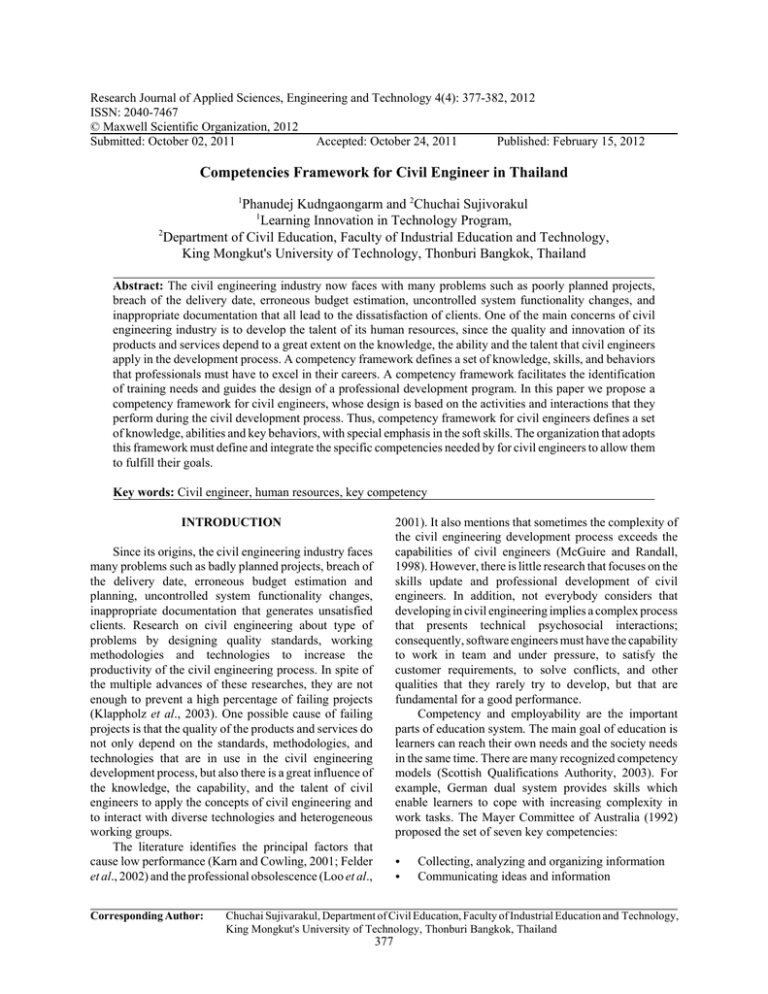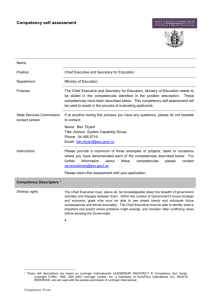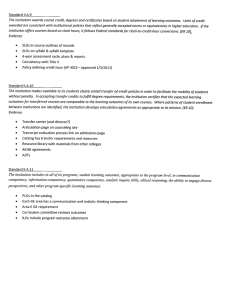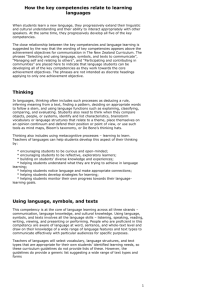Research Journal of Applied Sciences, Engineering and Technology 4(4): 377-382,... ISSN: 2040-7467 © Maxwell Scientific Organization, 2012
advertisement

Research Journal of Applied Sciences, Engineering and Technology 4(4): 377-382, 2012 ISSN: 2040-7467 © Maxwell Scientific Organization, 2012 Submitted: October 02, 2011 Accepted: October 24, 2011 Published: February 15, 2012 Competencies Framework for Civil Engineer in Thailand 1 Phanudej Kudngaongarm and 2Chuchai Sujivorakul 1 Learning Innovation in Technology Program, 2 Department of Civil Education, Faculty of Industrial Education and Technology, King Mongkut's University of Technology, Thonburi Bangkok, Thailand Abstract: The civil engineering industry now faces with many problems such as poorly planned projects, breach of the delivery date, erroneous budget estimation, uncontrolled system functionality changes, and inappropriate documentation that all lead to the dissatisfaction of clients. One of the main concerns of civil engineering industry is to develop the talent of its human resources, since the quality and innovation of its products and services depend to a great extent on the knowledge, the ability and the talent that civil engineers apply in the development process. A competency framework defines a set of knowledge, skills, and behaviors that professionals must have to excel in their careers. A competency framework facilitates the identification of training needs and guides the design of a professional development program. In this paper we propose a competency framework for civil engineers, whose design is based on the activities and interactions that they perform during the civil development process. Thus, competency framework for civil engineers defines a set of knowledge, abilities and key behaviors, with special emphasis in the soft skills. The organization that adopts this framework must define and integrate the specific competencies needed by for civil engineers to allow them to fulfill their goals. Key words: Civil engineer, human resources, key competency 2001). It also mentions that sometimes the complexity of the civil engineering development process exceeds the capabilities of civil engineers (McGuire and Randall, 1998). However, there is little research that focuses on the skills update and professional development of civil engineers. In addition, not everybody considers that developing in civil engineering implies a complex process that presents technical psychosocial interactions; consequently, software engineers must have the capability to work in team and under pressure, to satisfy the customer requirements, to solve conflicts, and other qualities that they rarely try to develop, but that are fundamental for a good performance. Competency and employability are the important parts of education system. The main goal of education is learners can reach their own needs and the society needs in the same time. There are many recognized competency models (Scottish Qualifications Authority, 2003). For example, German dual system provides skills which enable learners to cope with increasing complexity in work tasks. The Mayer Committee of Australia (1992) proposed the set of seven key competencies: INTRODUCTION Since its origins, the civil engineering industry faces many problems such as badly planned projects, breach of the delivery date, erroneous budget estimation and planning, uncontrolled system functionality changes, inappropriate documentation that generates unsatisfied clients. Research on civil engineering about type of problems by designing quality standards, working methodologies and technologies to increase the productivity of the civil engineering process. In spite of the multiple advances of these researches, they are not enough to prevent a high percentage of failing projects (Klappholz et al., 2003). One possible cause of failing projects is that the quality of the products and services do not only depend on the standards, methodologies, and technologies that are in use in the civil engineering development process, but also there is a great influence of the knowledge, the capability, and the talent of civil engineers to apply the concepts of civil engineering and to interact with diverse technologies and heterogeneous working groups. The literature identifies the principal factors that cause low performance (Karn and Cowling, 2001; Felder et al., 2002) and the professional obsolescence (Loo et al., Corresponding Author: C C Collecting, analyzing and organizing information Communicating ideas and information Chuchai Sujivarakul, Department of Civil Education, Faculty of Industrial Education and Technology, King Mongkut's University of Technology, Thonburi Bangkok, Thailand 377 Res. J. Appl. Sci. Eng. Technol., 4(4): 377-382, 2012 C C C C C and safety impacts of work processes and products such as buildings, utilities, systems, sites, mapping, or infrastructures including providing project management oversight, supervision of lower level staff; oversee or review environmental, infrastructure and manage implementation of projects/plans according to codes and regulations (North Carolina Board of Examiners for Engineers and Surveyors, 2008). Competency is the ability to perform a particular task at a certain level of expertise. Regarding to identify the competencies associated with a task or activity, consultants usually divide the job into two specific areas. The first area is called "core" competencies; these are the behavioural attributes essential to the successful completion of the work. These are the bottom-line, minimal skills and abilities that a person must have to even attempt the task. The second areas are “performance" competencies that focus on the skills and abilities associated with effective task execution. However, high levels of performance competency purport indicate that a person is capable of superior levels of task performance. The combination of core and performance competencies associated with a job creates a descriptive set of skills and abilities that are seen as predictive of effective performance (Nicoll, 2008). In Australia, competency is commonly defined as the ability to perform activities in an occupational function to the standard expected in employment. Therefore, competency is a measure of ability, regardless of how that ability has been acquired. Consequently, it is often held that the only determinant of competency is actual performance. In engineering, this is valid only if we understand in depth what constitutes dependable performance. Engineering involves highly disciplined approaches to complex matters so engineers must be well skilled these. Finally, competency might be summarized as a combination of knowledge, experience, and enterprise, so enterprise means the capacity to engage with new challenges and different circumstances because enterprise cannot be omitted or treated as additional part and separation. The most importance, every engineer has a responsibility to engage with the new and to help shape the future which is an integral part of their professional competence (Council of Engineers Australia, 2003). Planning and organizing activities Working with organizing activities Using mathematical ideas and techniques Solving problem Using technology (Werner, 1995) The competencies form a firm foundation for the identification of skills required to successfully participate in the world of work. However, these models were initiated according to its own circumstance as countries differ in social systems, ideology, historical tradition and cultural background. The goal of this research is to propose a competency framework that guides civil engineers to identify their training needs and to plan their professional development. The proposed competency framework is based on both the civil engineering activities and on the characteristics that are required for a civil engineer to perform those activities. The present study is mainly based on the information obtained from Thai civil engineering industry with a psycho-social approach. Our group traditionally does applied research in civil engineering considering both technical and social factors with the aim of providing solutions to problems in civil engineering industry. This study provides basic concepts, methodology, classifies competencies, defines the procedure, and describes our proposed competency framework. Finally, researchers provide some concluding remarks and some research directions for future study. LITERATURE REVIEW Competency theories and concepts: competence is the ability of professionals, who have the knowledge, expertise and attitude needed to execute the job. Lee (1999) and Huang (1996) stated that competence is the capability of doing their future jobs or activities. Based on the manager ability research, competence theory become mature and produces a number of generic competence models. Boyatzis (1982) believe that the competency model of managers including goals and operations management, leadership, human resource management, skills for direction underling, special knowledge (Boyatzis, 1982). Spencer and Spencer (1993) found that distinguish competence between good entrepreneurs and the general lies in achievement, personal maturity, leadership and control, etc., and build five general competency models, including sale staffs, community service personnel and so on (Spencer and Spencer, 1993).And the subsequent research. Civil engineer requirement of Thai industry: specific core competencies should be determined according to the enterprise demand, rather than the need of a science subject’s development needs, and in line with the basic principles of the specific core competence. The specific core competence should reflect the following unique feature of the professional core competencies, firstly reflected in the target of specific training, and closely linked to “Application capability” and “Explicating capability”; secondly reflected in the locating of serviceoriented, and thirdly in the school's operating Civil engineer competency: generally, engineers have competency profile with responsibility for consultation, investigation, evaluation and planning, design, design review and approval, and determination of environmental 378 Res. J. Appl. Sci. Eng. Technol., 4(4): 377-382, 2012 observations, interviews and questionnaires). Researcher spent three months to carry out the observations and interviews for each group. The observations and interviews focused on identifying the knowledge, attitudes and skills that the participator showed to perform their activities according to the civil engineering development process. For the analysis of the information we collecting data, classifies the data, and finally generates a theory. We also used functional analysis to identify core competencies that are fundamental to successfully complete the projects. The competencies are generic and are independent of the person who executes the task. characteristics (Xueqi and Shen, 2006). There was a research on “The Competency of Civil Engineering for Enterprises Requirement” in Thailand, it revealed that enterprise's requirement priorities covered ethic, skill, knowledge, and human relation (Klaoklaing et al., 2001). RESEARCH METHODOLOGY This study was to explore and examine the core competencies for civil engineer based on Thai civil engineering industry participator perceptions. It will provide a better understanding for educators to develop the appropriate training method. In this paper, we use the term competency in a holistic approach (Argu(elles, 1996); that is, we integrate in this term the functional and behavioral approaches. Thus, the term competency refers to the set of knowledge, abilities, and behaviors that professionals put in action in a specific context and that allow them to excel in the performance of their job functions and to fulfill the quality criteria that their job functions demand (Klein et al., 2004). C C C Data analysis: An initial study was conducted Thai civil engineering industry participator. The survey was on a 5point Likert-type scale. Data collection was done by questionnaires then the questionnaires were analyzed to find out the conclusion. Data analysis was done using SPSS/FW. The part with selection items was analyzed using frequency and percentage. The part with five scales was analyzed using mean (X) standard deviation (SD) and Correlation. The levels of agreement from respondents were as follows: 4.50-5.00 means definitely agree, 3.504.49 means strongly agree, 2.50-3.49 means quite agree, 1.50-2.49 means quite disagree, 1.00-1.49 means strongly disagree. The knowledge refers to the understanding of technical information and necessary to adequately perform a job function. The ability refers to the cognitive factors that represent the capability to effectively apply the knowledge on a specific job function. The behavior refers to the attitude that a professional shows as an affective positive or negative reaction towards an object and that determines the way the professional acts. RESULTS Classification and selection of competencies: For our convenience, researchers classify competencies under the following three categories: C Describing a working role by using competencies, facilitates organization's personnel management activities such as recruitment, career plan design, personnel performance evaluation, profile position design, compensation program design, training, and development program design (Aragón et al., 2004). A competency framework (or competency model) defines the set of knowledge, abilities and behaviors that professionals need to excel in the performance of their job functions. C C Technical: These competencies describe the job functions performed by the civil engineers Social: These competencies describe the abilities of civil engineers to interact with their work environments Personal: These competencies describe particular characteristics of the civil engineer These categories are interrelated and they collectively are the base to identify the competencies to keep the civil engineer in a competent level. The competencies that we select come from two different sources. First, from the methodology described in research framework; and second, from considering three factors: the market's needs, the characteristics of civil engineers, and the characteristics of the organizations that hire them. On the one hand, civil engineers need to rely on key competencies to adapt to environment where technologies change constantly and rapidly and working groups are now more diverse and fragmented than ever. On the other hand, companies need to satisfy the market's needs and to be profitable. The framework that we describe in this study focuses to individual competencies. Population and sample: Populations were the administrators and manager of 751 companies in Thailand. The Sampling group was composed of 1,400 Thai civil engineering industry participator. Research framework: Researchers studied two groups of Thai civil engineering industry participator. Fist group consist of 17 experts for synthesize the core competencies and identify perspectives on the core competencies with focus group technique. After that Second groups consist of 1,400 Thai civil engineering industry participator. Researchers used the ethnographic technique (field 379 Res. J. Appl. Sci. Eng. Technol., 4(4): 377-382, 2012 Social Technical Personality General basic vocation Information technology Handing and solving conflicts Constructional design Human relationship Drawing Cost examination Civil engineer Technique and construction practices Material test Personal Analysis and design Administration and management Development in the job environment Law and contract construction Personal development Saefty Rights and limits Fig. 1: Competencies framework for civil engineer in Thailand Table 1: Means and standard deviations expected competency and acceptable competency of civil engineer Expected competency Acceptable competency ----------------------------------------------------------Competency Technical General basic vocation Information technology Constructional design Drawing Construction cost estimation Technique and construction practice Material test Analysis and design Administration and management Law and construction Work system for building Safety construction Social Interpersonal relations Human relationship Handling and solving conflicts Personal Development in the job environment Personal development Rights and limits X SD X SD Rank 4.41 4.39 4.37 4.53 4.46 4.36 4.44 4.38 4.50 4.27 4.38 4.46 0.42 0.52 0.57 0.45 0.43 0.39 0.36 0.43 0.37 0.40 0.57 0.49 3.95 3.92 4.16 4.19 4.20 4.10 3.94 4.01 4.06 3.95 3.87 3.98 0.45 0.57 0.47 0.35 0.49 0.29 0.38 0.57 0.44 0.34 0.48 0.43 11 10 16 1 7 17 9 15 4 18 14 8 4.51 4.43 4.53 0.28 0.42 0.45 4.08 4.11 4.19 0.42 0.23 0.35 3 12 2 4.50 4.46 4.41 0.37 0.43 0.42 4.06 4.20 3.95 0.44 0.49 0.45 5 6 13 The work environments with the features mentioned above demands from the civil engineer competencies with special characteristics. However, the selected competencies are those that are useful in different areas and are necessary for the all civil engineers. The desirable characteristics of these competencies are: C C A competency framework consists of a specific set of competencies with an integrated approach. Table 1 shows C They must relate to economic and social measurable benefits 380 They must be useful in a wide spectrum of contexts; that is, they must be applicable to multiple areas of life They must be of specific use for a role, occupation, or task that the civil engineer performs in the development process Res. J. Appl. Sci. Eng. Technol., 4(4): 377-382, 2012 the most important competencies for civil engineers. Researchers sort them by divides competencies in groups: technical, social and personal. The findings illustrated that the expected competency in the aspects of: C C C C C C C C C C C C C C C C C C more definitive factor for their development as professional (Hansen, 2006). In order that civil engineers could contribute to the organization, it is necessary that they prepare, form, and acquire the necessary competencies and obtain satisfaction from it; for this reason, it is recommendable to regularly evaluate their performance, to determine if their labor goals are in conformity with the market and their long term plans as people General basic vocation Information technology Knowledge or skill in constructional design Knowledge in shop drawing and as built drawing Construction cost estimation Working technique and construction practice Material test Analysis, design, and behavior of fabricated structure Administration and management of construction Law, document, and contract of construction Work system for building Safety construction Attitude to personality Attitude to human relationship Handling and solving conflicts Development in the job environment Personal development Rights and limits have means of 4.41 (SD = 0.42), 4.39 (SD = 0.52), 4.37 (SD = 0.57), 4.53 (SD = 0.45), 4.46 (SD = 0.43), 4.36 (SD = 0.39), 4.44 (SD = 0.36), 4.38 (SD = 0.43), 4.50 (SD = 0.37), 4.27 (SD = 0.44), 4.38 (SD = 0.57), 4.46 (SD = 0.49), 4.51 (SD = 0.28), 4.43 (SD = 0.42), 4.53 (SD = 0.45), 4.50 (SD = 0.37), 4.46 (SD = 0.43) and 4.41 (SD = 0.42), respectively (Table 1). ACKNOWLEDGMENT I would like to express my great gratitude to King Mongkut's University of Technology Thonburi, without all the assistance the completion this study would not have been possible. Also, I wish to especially thank Assoc. Prof. Dr. Sak Kongsuwan for making some useful comments on both the concept of the evolutionary approach. I would sincerely like to thank committee of Minburi Technical collage for their valuable comments and suggestion. REFERENCES Aragón, A., et al., 2004. Fundaments of Management and Human Resource Management, Cengage Learning Editores, pp: 297 (In Spanish). Argu(elles, A., 1996. Competencia Laboraly Educación Basada En Normas De Competencia, Editorial Limusa, México, pp: 319. Boyatzis, R.E., 1982. The Competent Manager: A Model for Effective Performance. Wiley, New York. Council of Engineers Australia, 2003. Australian Engineering Competency Standards: General Introduction and Stage 2 Competency Standards for Professional Engineers ‘E ngineering Tchnologists’ Engineering Associates. 3rd Edn., Retrieved from: http://www.engineersaustralia.org.au/shadomx/app s/fms/fmsdownload.cfm?file-uuid=600A19C1-FE15BEB8-BC7B-0941CC0F1020&siteName=ieaust. Felder, R., G. Felder and E. Dietz, 2002. The effects of personality type on engineering student performance and attitudes. J. Eng. Educ., 91(1): 3-17. Hansen, E., 2006. Orientación Profesional: Unmanual de Recursos Para Países de Bajosy Medianos Ingresos, Montevideo: CINTERFOR/OIT. EMP/SKILLS, pp: 137. Huang, C., 1996. Increasing the quality of vocational: Education technological vocational Education. Bimonthly, 49: 6-13. Karn, J. and A. Cowling, 2001. An initial study of the effect of personality on group cohesion in software engineering projects, Department of Computer Science, Research Report, CS-04-01. University of Sheffield, England. CONCLUSION The proposed competency framework defines a set of knowledge, abilities and key behaviors, with special emphasis in the soft skills. The organization that adopts this framework must define and integrate the specific competencies needed by civil engineers to allow them to fulfill their goals. To simplify the definition of this competency framework for the civil engineer, researcher present Fig. 1 which shows specific competencies in each of the main groups described above. Organizations and individuals may use this framework as a guide and to adapt it to their needs. The competency framework is support civil engineers to develop and to advance in their work during their labor life in the organization. To face to the current challenges, civil organizations need a better way of developing the skills of their civil engineers to solve complex mental tasks. The competencies involve the mobilization of practical and cognitive skills, creative skills, and other psycho-socials resources like attitudes, motivation and values. The attitudes or behaviors of civil engineers and those of the organization are the strongest barriers that civil engineers have to face if they want to develop themselves as professionals. The disposition of civil engineers to adopt and acquire new competencies is a 381 Res. J. Appl. Sci. Eng. Technol., 4(4): 377-382, 2012 Nicoll, D., 2008. Competency Engineering, Retrieved from: http://www.oeinstitute.org/articles/comptengineering.html. North Carolina Board of Examiners for Engineers and Surveyors, 2008. Engineer Competency Profile, Retrieved from: http://www.doc.state.nc.us/docper/ Classification/Engineering/Engineer-cp.pdf Scottish Qualifications Authority 2003. Key Competencies-some International Comparisons. Policy and Research, Bulletin No. 2. Spencer, L.M. and S.M. Spencer, 1993. Competence at Work: Models for Superior Performance. John Wiley and Sons, New York, pp: 372, ISBN: 13: 9780471548096, Werner, M.C., 1995. Australian Key Competencies in an International Perspective. National Centre for Vocational Education Research, pp: 57-65. Xueqi, X.Y. and L. Shen, 2006. The Different Relationship of High-Tech and Low-Tech New Venture Teams’ Competencies with Venture Performances. IEEE International Conference on Management of Innovation and Technology. Klappholz, D., B. Lawrence and D. Port, 2003. Assessing attitude towards, knowledge of, and ability to apply, software development process. Proceeding of the16th Conference on Software Engineering Education and Training (CSEET'03), pp: 268. Klaoklaing,W., W. Siengsiew and S. Soontonopas, 2001. The Competency of Civil Engineering for Enterprises Requirement. B.S. Thesis, King MongkueNs Institute. Klein, J., M. Spector, B. Grabowski and I. de la Teja, 2004. Instructor Competencies: Standards for FaceTo-Face. Online and Blended Setting. 3rd Edn., Information Age Publishing: Greenwich, CT.. Lee, L., 1999. The Cross of Technology and Vocational Education. National Taiwan Normal University, Taipei, Taiwan. Loo, J., A. Grip and M. Steur, 2001. Skills obsolescence: Causes and cures. Proc. Inter. J. Manpower, MCB UP Ltd, 22(1-2): 121-138. McGuire, E., and K. Randall, 1998. Process improvement competencies for IS professionals: A survey of perceived needs. Proceedings of the 1998 ACM SIGCPR conference on Computer personnel research, March 26-28, Boston Massachusetts, pp: 1-8. 382




